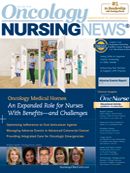Optimizing EHRs to Improve Cancer Screening in Older Adults
Electronic health records (EHR), which have been found to improve care and management of multiple chronic diseases in older adults, could also be customized to improve cancer screening rates in this population by integrating recommended screening protocols based on age, family history and other environmental, occupational, and behavioral risk factors (ie, smoking and alcohol use).
Rebecca Chia, PhD, RN
Rebecca Chia is Assistant Professor at Duquesne University School of Nursing in Pittsburgh, Pennsylvania.
Electronic health records (EHR), which have been found to improve care and management of multiple chronic diseases in older adults,1could also be customized to improve cancer screening rates in this population by integrating recommended screening protocols based on age, family history and other environmental, occupational, and behavioral risk factors (ie, smoking and alcohol use).
Recommended cancer screenings are critical for early detection and treatment of cancer, and including them in EHRs has the potential to reduce the disease burden of older adults already diagnosed with multiple chronic diseases.
An EHR provides electronic documentation and reporting capability for clinical processes of care, quality assurance, and administrative activities conducted by healthcare providers and hospitals.2The 2003 Institute of Medicine report set the standard for EHR by outlining core functions and key capabilities for building EHR systems and infrastructure.3National healthcare reform is fueling momentum for providers to use EHR for the collection, management, and analysis of accurate and comprehensive health information and data. Additionally, legislative and insurance reforms emphasize the use of EHR as an innovative strategy for improved quality of care and payment systems.4
In the past decade, government and the private sector have increased funding opportunities to promote quality and safety of healthcare through EHR implementation in primary care and hospitals. EHR is identified as a standard for patient-centered medical homes, which are touted as an important part of healthcare reform to make healthcare more accessible, cost efficient and safer, by encompassing patient quality and safety initiatives that include EHR with clinical decision support systems and patient registries.5Clinical decision support systems used to track recommended screening tests and procedures which facilitate improved chronic disease management for older adults could also be used to prompt cancer screenings in routine primary care visits.
Baby boomers (individuals born between 1946 and1964) are among the fastest growing age group in our nation, and are also likely to be diagnosed with one or more chronic conditions such as diabetes, cardiovascular disease, osteoarthritis, or dementia.6The Patient Protection and Affordable Care Act provides Medicare coverage for preventive health services including cancer screening; however, data suggest that health disparities such as social, economic, and/or environmental disadvantages, especially among certain racial and ethnic groups, may result in underutilization of preventive health services.6In addition, older adults with chronic diseases often have multiple providers and medication and treatment regimens that result in complex healthcare needs and behavior change to manage their conditions. Although older adults may be using health services for chronic disease management, providers need to do more to increase cancer screening.
An electronic medical record that incorporates guidelines for collecting data for specific clinical indicators and care processes has been found to increase efficiency and quality of care.7
Studies have shown that increased visit frequency and coordination of care by primary care providers has the greatest impact for improving rates of preventive care services such as cancer screening and improving health outcomes.5Appointment reminder systems integrated into EHR can be used to provide continuous and coordinated care by ensuring compliance with appointments, follow-up for positive screening tests, and referral to community resources for care and support services. In addition, links to patient education tools can be used to provide information to patients about the importance of cancer screening for early detection and treatment. This can provide opportunities for patients to ask questions, address fears, and correct misconceptions that may be barriers to compliance.
Nurses have the opportunity to interact with patients in all healthcare settings and the expertise to provide continuous coordination of care for improved health outcomes. Nurses also possess the expertise to act as patient advocates by providing education, support, and referral services to help patients maintain compliance with treatment plans and make better health behavior choices that impact their chronic disease management and overall health.
More research is needed to gain better understanding of the impact of EHR on cancer screening from the patient’s perspective, which will be important to consider as more providers and hospitals transition to EHR.
The author acknowledges Antonia Brewer, RN, MA, PhD student, Duquesne University School of Nursing, for her assistance in the preparation of this article.
Reference
- O'Connor PJ, Crain AL, Rush WA, et al. Impact of an electronic medical record on diabetes quality of care. Ann Fam Med. 2005;3(4):300-305.
- Miller RH, Sim I. Physicians' use of electronic medical records: barriers and solutions. Health Aff. 2004;23(2):116-126.
- Institute of Medicine. Committee on Data Standard for Patient Safety. Key Capabilities of an Electronic Health Record System: Letter Report. Washington, DC: The National Academies Press; 2003. http://www.nap.edu/openbook.php?record_id=10781. Accessed September 28, 2014.
- Buntin MB, Burke MF, Hoaglin MC, Blumenthal D. The benefits of health information technology: a review of therecent literature. Health Aff. 2011;30(3):464-471.
- Ferrante JM, Balasubramanian BA, Hudson SV, Crabtree BF. Principles of the patient-centered medical home and preventive services delivery. Ann Fam Med. 2010 Mar-Apr;8(2):108-116.
- US Department of Health and Human Services. Office of Disease Prevention and Health Promotion. Healthy People 2020. http://www.healthypeople.gov/2020/topicsobjectives2020/overview.aspx?topicid=8. Accessed August 22, 2014.
- Wagner EH, Austin BT, Davis C, et al. Improving chronic illness care: translating evidence into action. Health Aff. 2001;20(6):64-78.

Shared Model of Care Post-HCT Offers Safe Follow-Up, Reduces Patient Burden
Published: March 19th 2025 | Updated: March 19th 2025Alternating post-HCT care between specialized facilities and local cancer centers produced noninferior non-relapse mortality and similar quality of life to usual care.



